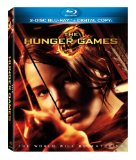
Young adult fiction is popular these days, for better or worse. The young adults who read it, obsess over it and turn out in mass for movies based on the source material aren’t always so young. The obsession over and popularity of a series like The Hunger Games makes it difficult to create a good flick. Fans these days tend to demand a faithfulness to the source or they’ll riot, digitally of course, but still. I’m in the envious position of never having read any of the three books. After all, my favorite novel is: I’ll wait for the movie. I consider this a blessing when taking in movies based on modern day popular books. I’m more interested in a good film than allegiance to the author’s writings.
The story behind the film is not completely original. I won’t mention other films which have used similar narratives before because it doesn’t matter. It’s not unlike those who bemoan the cycle of bands whose only purpose seems to be to reinvent what came before. The complaint is one of, why bother? What is missed is that it may have been done before but not for this audience, not by this set of artists. I view The Hunger Games in a similar manner. The story is an interesting one regardless of its originality or lack thereof.
The future is not looking bright. It’s dystopian outside and the select few with wealth and power lord it over the rest. The capitol city is bright, high gloss, wine and dine. The surrounding districts are dark and dingy. In celebration of society’s survival from a nuclear fallout there is a televised competition in which two kids from each district are randomly selected to compete. First prize is you live another day. Second prize is you’re dead. Fairly simple rules, if not the greatest way to commemorate mankind’s continued existence.
Long story short, Katniss (Jennifer Lawrence) volunteers to take the place of her younger sister who was picked. She and Peeta represent their district. They train and put on a show to win support of those watching. Viewers can provide help during the competition, though how this is done is not clear, it simply happens. The games begin and lots of kids are killed. For those disturbed by this tale being for a younger audience I will point out that fairy tales could be pretty gruesome as well. Granted, the deaths didn’t normally involved knives, swords, genetically modified dogs and insects, but there were plenty of children meeting their early demise in stories much older than The Hunger Games.
The vast difference of the world between those in the capitol city and those outside it are interesting. Those on the inside wear garish costumes while those on the outside are perfectly dressed for a Charles Dickens novel. The outside districts are about harvesting raw materials to keep those in the high tech city moving along. The dichotomy is intentional if not a little too on the nose. No matter, it’s made clear there are two classes in this society and one is there to work for the other. One class is so subservient it offers up its children to the world’s worst reality TV show.
Katniss is a teenage girl capable of taking care of herself. Early on we see how she moves fluently through the forest hunting food for family. She is convinced no one is looking out for her good. She probably has a point. Every year she lines up waiting to hear her name called for the honor to battle other kids to the death on television. When she discovers one of the keys to surviving and winning the game is to win the hearts of those in the audience, it’s as if she’s already lost. She is no nonsense; and pretending to enjoy the experience of being thrown into the lion’s den for entertainment purposes tips the nonsense scale. She and Peeta have advisors who guide them through the process. They attempt to make Katniss and Peeta as different and as winsome as any two competitors have ever been.
Once the games begin the excitement is less than one might expect considering the setup. The action set pieces are mostly not there. The moral dilemmas presented by the competition and the way the (mostly) reluctant participants go about it are often side stepped with quick and easy solutions. Since the focus is mostly on Katniss the other characters seem almost inconsequential, even as they die painful deaths. Thankfully there is enough cat and mouse action to hold interest. And while some have made a big deal about the shaky cam technique being awful, I thought it fit in nicely with the tight focus on Katniss’ story. Then again, I liked Cloverfield. Nothing goes too far off the rails until there are, inexplicably, miraculously created obstacles which appear out of nowhere on command from central control. Apparently we’re in a world where there is still a need for coal and other natural materials, but the ability to create fireballs and monster dogs out of thin air is easy peasy.
There is an unevenness to The Hunger Games, which is at least partially due to there being two more books to cover. The story is good and the execution is solid if not spectacular. Our reluctant heroine holds interest throughout, even in those moments when the parts don’t make a cohesive whole. There is enough here to serve as a good launching point for the next films. Of course, if we’re to read the tea leaves set forth by its predecessors (Harry Potter, Twilight), we’ll likely see more than two films follow this one. For better or worse.
[xrr rating=3.5/5 label=” “]
This post is part of my Way late reviews. Read more reviews here.
[youtube width=”640″ height=”360″]http://www.youtube.com/watch?v=mfmrPu43DF8[/youtube]